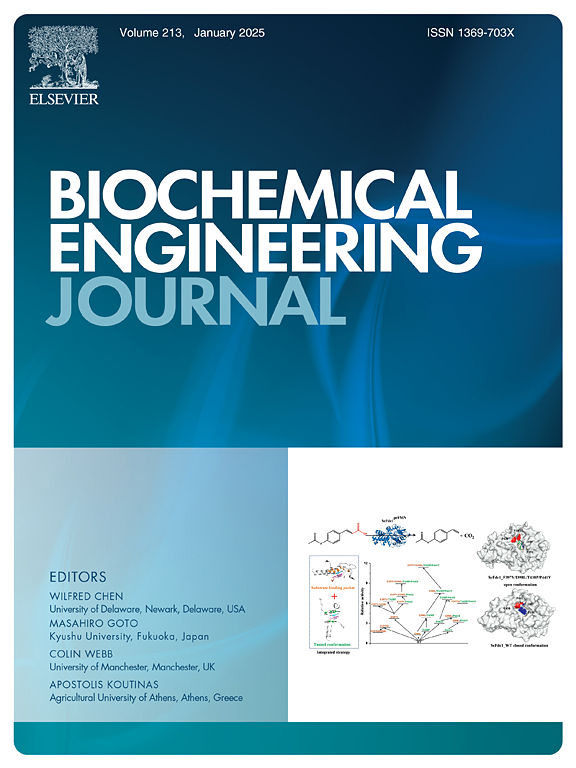酿酒酵母LMQA SRC-143和PE-2与发酵乳杆菌共培养的发酵和生理反应:用流式细胞术观察Melle-Boinot过程
IF 3.7
3区 生物学
Q2 BIOTECHNOLOGY & APPLIED MICROBIOLOGY
引用次数: 0
摘要
在发酵过程中多种微生物的存在仍然是控制和高产乙醇生产的主要挑战。因此,在涉及种间相互作用时,选择能够维持或增强其生物技术活性的菌株是至关重要的。本研究旨在评估由发酵乳杆菌CCT 1668介导的微生物竞争,以及细胞循环和酸洗对酿酒酵母LMQA SRC-143和PE-2菌株发酵性能和生理反应的影响。流式细胞术用于评估整个发酵周期的细胞活力、活力和细胞内碳水化合物储备。研究结果挑战了传统观念,即乳酸菌共培养在发酵过程中普遍有害。有趣的是,尽管PE-2在分离后表现出更高的恢复力,但L. fermentum的存在显著提高了LMQA SRC-143的性能和活力。这项研究强调了利用微生物相互作用来优化发酵过程的潜力,以生物乙醇生产为例,表明某些非商业酵母菌株不仅可以承受细菌共培养,而且在特定条件下也会受益。这些见解对发酵行业具有重要意义,因为它们可以减少对细菌控制的化学干预的依赖,促进符合可持续发展目标7(负担得起的清洁能源)的更可持续的方法。本文章由计算机程序翻译,如有差异,请以英文原文为准。
Fermentative and physiological responses of Saccharomyces cerevisiae LMQA SRC-143 and PE-2 in co-culture with Lactobacillus fermentum: Insights with flow cytometry in the Melle-Boinot process
The presence of multiple microbial species during the fermentation process remains a major challenge for controlled and high-yield ethanol production. Therefore, it is essential to select strains capable of maintaining or enhancing their biotechnological activity when involved in interspecies interactions. This study aimed to assess the impact of microbial competition, mediated by Lactobacillus fermentum CCT 1668, along with cell recycling and acid washing, on the fermentative performance and physiological responses of Saccharomyces cerevisiae strains LMQA SRC-143 and PE-2. Flow cytometry was employed to assess cell vitality, viability, and intracellular carbohydrate reserves throughout the fermentation cycles. The results challenge the conventional notion that lactic acid bacteria co-culture is universally detrimental during fermentation. Interestingly, while PE-2 exhibited higher resilience when isolated, the presence of L. fermentum significantly enhanced the performance and vitality of LMQA SRC-143. This research underscores the potential of exploiting microbial interactions to optimize fermentation processes, using as an example the bioethanol production, suggesting that certain non-commercial yeast strains may not only withstand bacterial co-culture but also be benefited under specific conditions. These insights carry significant implications for the fermentation industry, as they could reduce dependency on chemical interventions for bacterial control, promoting more sustainable approaches aligned with SDG 7 - affordable and clean energy.
求助全文
通过发布文献求助,成功后即可免费获取论文全文。
去求助
来源期刊

Biochemical Engineering Journal
工程技术-工程:化工
CiteScore
7.10
自引率
5.10%
发文量
380
审稿时长
34 days
期刊介绍:
The Biochemical Engineering Journal aims to promote progress in the crucial chemical engineering aspects of the development of biological processes associated with everything from raw materials preparation to product recovery relevant to industries as diverse as medical/healthcare, industrial biotechnology, and environmental biotechnology.
The Journal welcomes full length original research papers, short communications, and review papers* in the following research fields:
Biocatalysis (enzyme or microbial) and biotransformations, including immobilized biocatalyst preparation and kinetics
Biosensors and Biodevices including biofabrication and novel fuel cell development
Bioseparations including scale-up and protein refolding/renaturation
Environmental Bioengineering including bioconversion, bioremediation, and microbial fuel cells
Bioreactor Systems including characterization, optimization and scale-up
Bioresources and Biorefinery Engineering including biomass conversion, biofuels, bioenergy, and optimization
Industrial Biotechnology including specialty chemicals, platform chemicals and neutraceuticals
Biomaterials and Tissue Engineering including bioartificial organs, cell encapsulation, and controlled release
Cell Culture Engineering (plant, animal or insect cells) including viral vectors, monoclonal antibodies, recombinant proteins, vaccines, and secondary metabolites
Cell Therapies and Stem Cells including pluripotent, mesenchymal and hematopoietic stem cells; immunotherapies; tissue-specific differentiation; and cryopreservation
Metabolic Engineering, Systems and Synthetic Biology including OMICS, bioinformatics, in silico biology, and metabolic flux analysis
Protein Engineering including enzyme engineering and directed evolution.
 求助内容:
求助内容: 应助结果提醒方式:
应助结果提醒方式:


